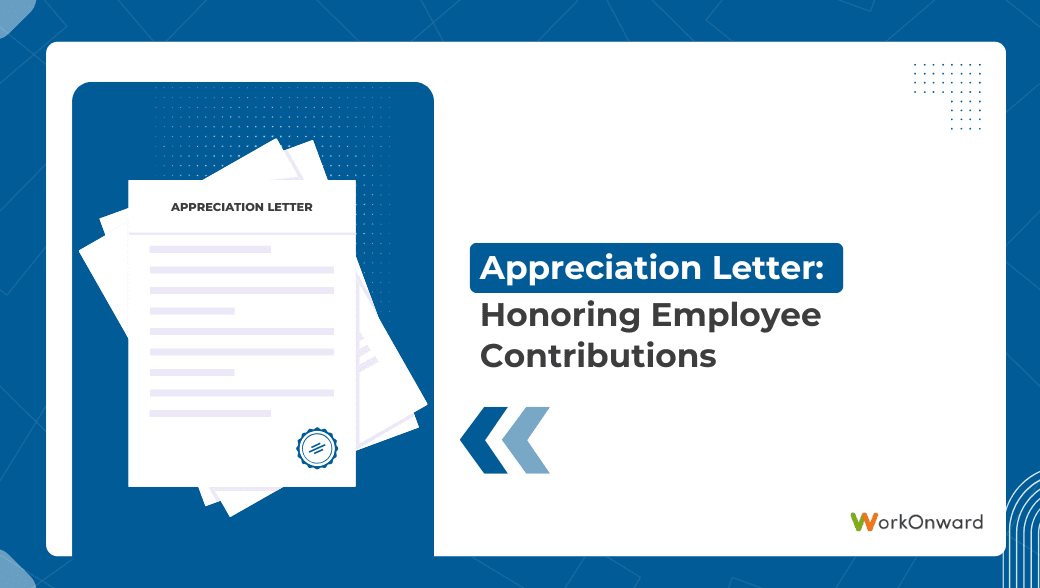An appreciation letter is the most powerful tool in the company's employee recognition strategy. While it goes far beyond just acknowledging someone's efforts, it serves as a key instrument in boosting morale, fostering loyalty, and maintaining a positive work culture. Be it for dedication, hard work, or some form of achievement, an appreciation letter plays a great role in cementing those efforts.
In this blog, we will find importance, when to write appreciation letters, must-have elements in an appreciation letter, and how you can use tools like WorkOnward to make it easier.
What is an Appreciation Letter?
An appreciation letter is an official piece of paper that communicates the formality of thankfulness regarding an employee's contributions to the organization. An appreciation letter mainly encompasses outstanding achievements or quality about an employee, emphasizes his efforts, and inspires the individual towards good things to bring the organization positive outcomes Unlike any official communication, an appreciation letter holds a personal and emotional undertone that presents the organization's true acknowledgment for the efforts put forth by the employee.
Why is an Appreciation Letter Important?
1. Improve Morale
Recognition is the most powerful motivator of all. Once workers feel valued and appreciated, they are more likely to stay involved and committed. Appreciation letters enhance employee morale because it makes employees proud of the contributions they have made.
2. Encouraging Continued Excellence
An appreciation letter inspires the employees to sustain or enhance their performance by appreciating specific achievements and contributions. This provides positive reinforcement that encourages the employees to exceed expectations in their jobs.
3. Strengthening Employee-Employer Relationships
A genuine appreciation letter strengthens the bond between the employee and the employer. Trust and respect become essential elements in creating a good culture at work.
4. Turnover Reduction
When employees feel appreciated and recognized for their work, they are more likely to remain with the organization. Appreciation letters can be a key element in employee retention strategies.
5. Promoting a Positive Work Culture
A culture of recognition promotes a positive work environment. When employees witness their colleagues being appreciated, it can motivate them to improve their own performance and contribute to a culture of excellence.
When to Write an Appreciation Letter?
There are many situations where writing an appreciation letter is appropriate. Some of the most common scenarios include:
1. After Completing a Successful Project
When an employee or a team completes a major project successfully, sending an appreciation letter acknowledges their efforts and reinforces their contribution to the success of the organization.
2. For Long-Term Service
Employees who have been with the company for several years deserve recognition for their loyalty and dedication. A long service appreciation letter shows gratitude for their commitment to the organization.
3. To Exceed and Beyond
In most cases, there are workers who take some time to offer support to colleagues, or simply help out where there is need. A letter of appreciation might help the employee realize why they should maintain these qualities and go on acting like that.
4. Core Values Exhibit by an Employee
Appreciation letters might be used for workers who uphold core values exhibited in the workplace such as teamwork, customer services, or innovations.
5. Personal Celebrations
Recognizing personal milestones, such as birthdays, work anniversaries, or significant life events, also provides an opportunity to send an appreciation letter to acknowledge the employee's importance to the organization.
Key Components of an Appreciation Letter
A good appreciation letter should contain a few key components that make it meaningful and impactful. Here's what to include:
1. Greeting and Introduction
SStart the letter with a personalized greeting. Address the employee by name, and then introduce him briefly to explain the purpose of the letter.
Example: "Dear [Employee's Name], We wished we could have grabbed this chance to sincerely thank the outstanding work from you all the last year."
2. Appreciation by specific accomplishment or actions
Point out specific work performed, projects you are celebrating or behaviors which can be illustrated to show this was what he/ she got it right.
Example: "Your leadership in the [project name] was invaluable, and your attention to detail ensured that everything ran smoothly. Your commitment to meeting deadlines and ensuring that the project went well was not ignored."
3. The Impact of Their Contributions
Describe in detail how the work of the employee has had a positive impact for the company, the team, or customers. This underlines the value of their input.
For example: "It is because of your endeavors that our team had completed the project in due time when the client was really celebrating such an excellent finish. This has sure strengthened relations with the client, and it will contribute a great deal to sustaining this business further."
4. Motivate Next Contributions
Make the employee reflect on his excellent quality work delivery going forward and contemplate your assurance with regards to succeeding in the next attempt.
Example: "We are confident that you will continue to exceed expectations, and we look forward to seeing the many ways you will contribute to the success of our team and company in the future."
5. Closing and Signature
End the letter with a positive note, thanking the employee again for all his efforts and continued support.
Example: "Thanks again for your commitment and dedication. We feel so privileged to have you on board. Best regards, [Your Name] [Your Position]"
Sample Appreciation Letter

How WorkOnward Can Support Employee Recognition
WorkOnward is well aware of the importance of creating a positive workplace culture with recognition as one of its core values. Our platform streamlines the employee recognition process, enabling HR professionals and managers to track employee performance easily, send personalized appreciation messages, and ensure that recognition is timely and impactful.
Here are a few features of WorkOnward that can support your recognition efforts:
Centralized employee profiles display all the achievements, milestones, and performance feeds so that moments of appreciation can be identified easily.
Tracking Performance: Analyze data-driven insights to find employees who are always over-achievers.
Automated Recognition Reminders: Be reminded automatically when an appreciation letter should be sent for achievements and milestones.
Customizable Templates: Take advantage of pre-designed templates created to craft personalized appreciation letters in no time.
With WorkOnward, you can create a culture of appreciation that drives employee engagement, motivation, and loyalty. Start using WorkOnward today to elevate your employee recognition practices and make appreciation a cornerstone of your organization's success.
Conclusion
More than a mere gesture, appreciation letters are a mighty tool for positive behavior reinforcement, improving morale, and creating a workplace culture of recognition. By the time you spend writing a letter of appreciation to an employee, you are, in fact acknowledging their hard work and inspiring them to continue this excellent performance.
With the help of WorkOnward's comprehensive tools in HR, the process of identifying employees becomes relatively easier and even more effective, be it tracking performance, automation of reminders, or even ready-to-use customizable templates. And no employee work goes unnoticed on your part.
Ready to streamline your employee recognition process? Join WorkOnward today and get appreciation into the DNA of your organization.







